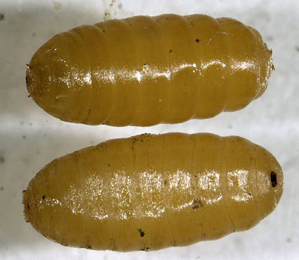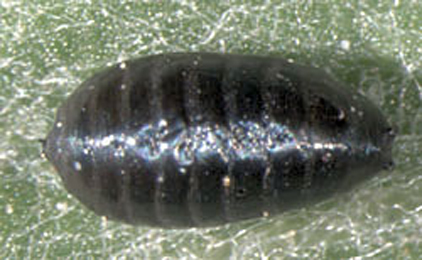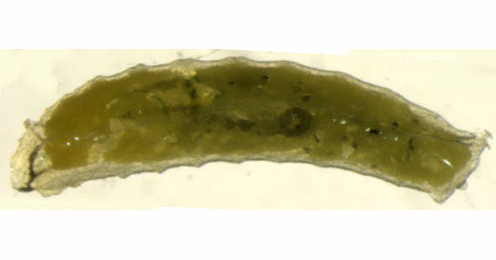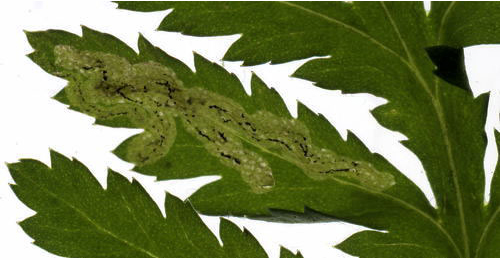 |
| |
(Coleoptera, Diptera, Hymenoptera and Lepidoptera)
by
Brian Pitkin, Willem Ellis, Colin Plant and Rob Edmunds
|
|
|
|
ARTEMISIA.
Mugworts and Wormwoods [Asteraceae]
|
|
Numerous
species of Artemisia are recorded in Britain. Four species
are native - Wormwood (A. absinthium), Field Wormwood (A.
campestris), Norwegian Mugwort (A. norvegica) and Mugwort
(A. vulgaris). An additional seventeen species are introduced,
including Tarragon (A. dracunculus), Annual Mugwort (A.
annua), Slender Mugwort (A. biennis), Hoary Wormwood
(A. stelleriana), Chinese Mugwort (A. verlotiorum)
and Shrub Southernwood (A. abrotanum). The BSBI provide a downloadable plant crib for Artemisia.
Field
Wormwood (A. campestris) is protected under Schedule 8 of
the Wildlife and Countryside Act, 1981.
Eighteen or nineteen Brish miners are recorded on Artemisia.
The
polyphagous agromyzid Liriomyza
trifolii has been recorded in quarantine in Britain (Pitkin & Plant in British leafminers). See also Liriomyza species in Glasshouses and/or Quarantine Interceptions.).
Although
there is a record of the agromyzid Agromyza
abiens on Artemisia vulgaris (Robbins, 1991) this
is unlikely to be correct, as this species mines Boraginaceae. There
is also a record of Aulagromyza
discrepans on Artemisia (Robbins, 1991), but as the
mine has not previously been described, the record needs confirmation.
The
agromyzid Melanagromyza
oligophaga bores within the stems of Achillea
and Artemisia in Britain.
The
coleophorid Coleophora
artemisicolella is recorded as a seed-feeder on Artemisia
in Britain.
A key to the European miners recorded on
Artemisia is provided in Bladmineerders van Europa.
|
Key for the identification of the known mines of British
Diptera recorded on Artemisia
|
Note: Diptera larvae may live in a corridor mine, a corridor-blotch mine, or a blotch mine, but never in a case, a rolled or folded leaf, a tentiform mine or sandwiched between two more or less circular leaf sections in later instars. Pupation never in a cocoon. All mining Diptera larvae are leg-less maggots without a head capsule (see examples). They never have thoracic or abdominal legs. They do not have chewing mouthparts, although they do have a characteristic cephalo-pharyngeal skeleton (see examples), usually visible internally through the body wall. The larvae lie on their sides within the mine and use their pick-like mouthparts to feed on plant tissue. In some corridor miners frass may lie in two rows on alternate sides of the mine. In order to vacate the mine the fully grown larva cuts an exit slit, which is usually semi-circular (see Liriomyza huidobrensis video). The pupa is formed within the hardened last larval skin or puparium and as a result sheaths enclosing head appendages, wings and legs are not visible externally (see examples).
See Key to non-Diptera.
|
1a >Stem-miner: A
narrow, inconspicuous stem mine. Pupation at the end of the mine
(Spencer, 1976: 64).
Fine,
upper- or lower-surface corridor, ending in a thick vein. From there
the mine extends finally to the rind of the stem. There also the
pupation takes place, usually not far from the root collar. Mines
in the stem rind often are conspicuous through a red discoloration. |
On Achillea, Achillea millefolium and possibly Anthemis,
Matricaria and Medicago sativa, but not yet on Artemisia, in Britain. In Britain widespread in south, not uncommon. On Anthemis, Achillea, Artemisia, Aster, Centaurea, Clinopodium, Crepis, Hieracium, Matricaria, Reichardia, Solidago, Tanacetum, Tripleurospermum, Medicago, Satureja and Stachys elsewhere. Widespread in continental Europe.
|
Ophiomyia
curvipalpis (Zetterstedt, 1848) [Diptera: Agromyzidae]. |
1b > Leaf-miner |
2 |
2a > Leaf-miner: Blotch mine. |
3 |
2b > Leaf-miner: Corridor mine. |
4 |
3a > Leaf-miner: A
whitish-greenish blotch. Pupation external, on the ground (Spencer, 1972b: 43, fig. 140; Spencer,
1976: 306-7, fig. 552).
A
chacteristically pale whitish, usually upper-surface, primary blotch.
There is an initial corridor, but traces of it are almost always
overrun by the later blotch. The mine is quite opaque; only by opening
it can it be ascertained if the mine is still occupied. No feeding
lines are apparent. Unlike other blotch mines thay may occur here, Calycomyza mines are totally flat. Pupation outside the mine.
A whitish blotch mine occuring on the upper leaf surface. Starts with a short corridor and does not show feeding lines. Superficially similar to the lepidopterous mine made by Leucospilapteryx omissella, but the latter mine turns purple as it ages. |
|
On Artemisia and Eupatorium in Britain and additional
Asteraceae elsewhere. Widespread in England and Continental Europe.
Also recorded in China, Japan, Colombia and Canada.
|
Calycomyza
artemisiae (Kaltenbach, 1856) [Diptera: Agromyzidae]. |
3b > Leaf-miner: The
mine begins as an elongated blotch overlying a strong vein; from
there broad tunnels radiate that coalesce in the end. All frass
is concentrated at a central point in the floor of the mine. As
a result the mine has a brownish-black centre and a paler brownish
green seam. The larva often (perhaps always at daylight) rests in
the centre of the mine. Primary and secondary feeding lines as a
rule quite clear. Pupation outside the mine.
An elongated blotch centred over a vein. There are two types: greenish with a blackish centre and entirely reddish-black. |
|
|

Trypeta artemisiae pupariria
Image: © Willem Ellis (Bladmineerders van Europa) |
On
numerous genera of Asteraceae, including Artemisia, in Britain and elsewhere. In Britain
more common in the north than in the south. Also throughout the
Palaearctic Region except the Mediterranean and Middle Eastern
areas.
|
Trypeta
artemisiae (Fabricius, 1794) [Diptera: Tephritidae]. |
3c > Leaf-miner: Blotch mine (Spencer, 1990:
299).
The
mine is a large whitish underside blotch with clear feeding lines
and pupation is external (Robbins,
1989: 117).
The
mine starts as a star-shaped interparenchymatous blotch near the
midrib. This is followed by a broad, corridor-like arc around the
central part of the leaf tip. The circumcised section of the leaf
dies off and remains as a black patch in the centre of the mine.
Primary and secondary feeding lines well visible in fresh leaves.
Frass in coarse grains. Often several mines coalesce into one. Pupation
outside the mine; semicircular exit slit in the upper epidermis. |
On Artemisia in Britain and elsewhere. First recorded from
Coventry in Britain. Widespread in continental Europe
|
Agromyza
rufipes Meigen, 1830 [Diptera: Agromyzidae]. |
4a > Leaf-miner: A distinctive mine primarily above mid-rib, with irregular short
lateral offshoots into leaf blade. Pupation external (Spencer, 1972:
51 (fig. 172), 55; Spencer, 1976:
270, 271 (fig. 486)).
Branched,
whitish, upper-surface corridor; main axis overlying the midrib;
side branches overlying the main lateral veins. (In Campanula and Phyteuma the mine is much less branched, sometimes nothing
more than a corridor on top of the midrib). Frass in rather long
strings. Usually the mines begins as a long and narrow, shallow,
tortuous lower-surface corridor that ends upon the midrib but otherwise
is not associated with the leaf venation. Often this initial corridor
is filled with callus, and then even less conspicuous. Pupation
outside the mine.
A
linear mine on the upper surface, usually following the midrib and
showing side branches along the veins. The frass is in strings. |
|

Liriomyza strigata larva, lateral
Image: © Willem Ellis (Bladmineerders van Europa)
|
Polyphagous. On more than 40 host genera in 15 families, including Artemisia, in Britain. Widespread
throughout Britain. Also recorded in the Republic of Ireland.
Widespread in continental Europe.
|
Liriomyza strigata (Meigen, 1830) [Diptera: Agromyzidae]. |
4b > Leaf-miner: Mine linear, whitish, both upper and lower surface. Pupation internal,
at the end of the mine with the anterior spiracles projecting through
the epidermis (Spencer, 1976:
433).
Upper-surface,
less often lower-surface corridor. Frass in isolated grains. Pupation
within the mine, usually in a lower-surface puparial chamber.
A long whitish upper surface corridor, which eventually goes lower surface. |
|
|
Two
highly polyphagous species of Chromatomyia, with indistinguishable
mines, have been recorded in Britain. These are syngenesiae (Hardy) and horticola (Goureau, 1851) which can only be distinguished by the male genitalia. Both species are widespread in Britain and elsewhere, although syngenesiae is almost entirely restricted to Asteraceae. Records on Asteraceae not based on examination of male genitalia are treated in this account as Chromatomyia 'atricornis'.
Chromatomyia syngenesiae is recorded on Artemisia elsewhere but not yet on Artemisia in Britain.
Chromatomyia 'atricornis' has been recorded on Artemisia in Britain.
|
Chromatomyia
horticola (Goureau, 1851) [Diptera: Agromyzidae]
OR
Chromatomyia
syngenesiae Hardy, 1849 [Diptera: Agromyzidae]. |
4c > Leaf-miner: The
mine begins as a long, quite narrow corridor, usually not far from
the tip of a leaf segment. Usually this corridor follows the leaf
margin for some distance, but it may also run freely through the
blade and may then be stongly contorted. In the end the corridor
is directed towards the midrib, where an elongated blotch is formed,
overlying the midrib and some of the larger lateral veins. Frass
in a nearly continuous line in the initial corridor, in scattered
lumps in the later part of the mine. Primary and secondary feeding
lines very conspicuous when seen in transparancy. Pupation outside
the mine.
The mine starts as a very narrow corridor, usually close to the tip of a leaf segment and following the leaf margin. The later section of the corridor approaches the main vein, where an elongated blotch is made with long broad finger like extensions that lay over the secondary veins. In the initial corridor the frass forms an almost continuous line, in the blotch it is distributed in large scattered lumps. In fresh mines the secondary feeding lines are clearly visible. |
|
|
|
On
numerous genera of Asteraceae, including Artemisia, in Britain, Throughout the British Isles, more
common in the south than the north. Also continental Europe.
|
Trypeta
zoe Meigen, 1826 [Diptera: Tephritidae]. |
4d > Leaf-miner: Mine
long, whitish, frequently adjoining a vein with frass in separate
grains (Spencer, 1976: 387,
fig. 675).
Little
widening upper-surface corridor, up to 8 cm long; sometimes the
first part lower-surface. Often the corridor follows a vein or the
leaf margin for some distance. The sides are initially quite smooth,
later they may be more irregular. Primary feeding lines often visible.
Frass in pearl chains and isolated grains, in two neat rows - closely
resembling the frass pattern of Liriomyza's. The whitish larva leaves
the mine before pupation; exit slit in upper epidermis.
The mine is a long corridor, which often partly follows the veins of the leaf, or leaf margin. The frass is in separate grains, with the appearance of stings of pearls. |
|
|

Phytomyza artemisivora puparium. dorsal
Image: © Willem Ellis (Bladmineerders van Europa) |
On Artemisia in Britain and elsewhere. Widespread in Britain.
Also recorded in the Republic of Ireland. Common and Widespread
in continental Europe, range extending eastwards to the Kirghiz
Republic of the [former] U.S.S.R.
|
Phytomyza
artemisivora Spencer, 1971 [Diptera: Agromyzidae]. |
4e > Leaf-miner: Generally associated with mid-rib or leaf margin and relatively
long (Spencer, 1976: 243).
Upper-surface
corridor, generally descending from the tip of a leaf segment toewards
the centre along a vein or the leaf margin. Frass in strings. Pupation
outside the mine.
An upper surface gallery of moderate length, mostly alongside a vein. The corridor is long and loose, with stringy frass.
Puparium yellow |
|

Liriomyza demeijerei larva, lateral
Image: © Willem Ellis (Bladmineerders van Europa) |
On Artemisia in Britain and elsewhere. Uncommon in Britain.
Widespread in continental Europe.
|
Liriomyza
demeijerei Hering, 1930 [Diptera: Agromyzidae]. |
| 4f > Leaf-miner: A short rather broad linear mine, usually confined to a single leaf
segment. Pupation external (Spencer,
1976: 232).
Upper-surface
short and broad corridor, or more often a secondary blotch, normally
restricted to the tip of one leaf segment. Frass in strings. The
yellow larva leaves the mine before pupation. Feeding punctures
lower-surface.
Forms compact, very convoluted mines, with stringy frass. |
|
|
On Artemisia in Britain and elsewhere. Widespread in Britain
and central and western Europe.
|
Liriomyza
artemisicola Meijere, 1924 [Diptera: Agromyzidae]. |
| 4g > Leaf-miner: A narrow linear mine, with frass in black strips (Spencer, 1972b: 57; Spencer, 1976:
274). Narrow upper-surface corridor.
The
corridor often follows nerves, causing it to branch now and then.
Frass in strings. Pupation outside the mine.
Puparium
yellowish-black |

Mine
of Liriomyza tanaceti on Tanacetum vulgare
Image: © Willem Ellis (Bladmineerders van Europa) |
On Artemisia, Chrysanthemum and Tanacetum in Britain
and Tanacetum elsewhere. Known only from Surrey and Warwick
in Britain. Widespread and not uncommon in much of western Europe
|
Liriomyza
tanaceti Meijere, 1924 [Diptera: Agromyzidae]. |
4e> Leaf-miner: A narrow linear mine commencing on lower surface (Spencer, 1972b: 57; Spencer, 1976:
264).
Narrow
brownish corridor, either upper- or lower-surface. Frass in strings
or pearl chains. Pupation outside the mine. In small leaves the
mine can be full-depth and occupy the entire leaf. At least in Achillea millefolium mines are generally found in the top
half of the leaf. |
|
|
On Achillea ptarmica and Achillea millefolium, but not yet on Artemisia, in Britain
and elsewhere and other species of Achillea elsewhere.
Probably widespread in Britain, at least in south. Widespread
in continental Europe and also recorded from Canada.
|
Liriomyza
ptarmicae Meijere, 1925 [Diptera: Agromyzidae]. |
| |
Key for the identification of the known mines of British
non-Diptera recorded on Artemisia
|
Note:
The larvae of mining Coleoptera, Hymenoptera and Lepidoptera may live in a corridor mine, a corridor-blotch mine, a blotch mine, a case, a rolled or folded leaf, a tentiform mine or sandwiched between two more or less circular leaf sections in later instars. Larva may pupate in a silk cocoon. The larva may have six legs (although they may be reduced or absent), a head capsule and chewing mouthparts with opposable mandibles (see video of a gracillarid larva feeding). Larvae of Hymenoptera and Lepidoptera usually also have abdominal legs (see examples). Frass, if present, never in two rows. Unless feeding externally from within a case the larva usually vacates the mine by chewing an exit hole. Pupa with visible head appendages, wings and legs which lie in sheaths (see examples).
|
1a > Leaf-miner and case-bearer: The larva lives outside the mine, protected by a case, and feeds on the underlying plant tissues via a hole cut in the epidermis. From that point it eats away as much leaf tissue as it can reach without fully entering the mine. Mine does not contain frass (Coleophora species) |
2 |
1b > Leaf-miner,
but not a case-bearer: The larva lives inside the mine. Mine usually contains frass |
3 |
2a > Leaf-miner
and case-bearer: A straw-coloured to grey, slender, three-valved case of he type
tubular silken case; mouth angle 45° - 60°. The case resembles
that of C. trochilella, but the case is more slender, the mouth
is narrower and the constriction behind the mouth less deep. |
On Achillea millefolium, Achillea ptarmica, Artemisia maritima,
Leucanthemum vulgare and Tanacetum vulgare elsewhere.
Recorded in North Hants and South Hants in Britain. Widespread
in other parts of Europe and elsewhere.
|
Coleophora
gardesanella Toll, 1954 [Lepidoptera: Coleophoridae].
|
2b > Leaf-miner
and case-bearer: A straw-coloured, slender, three-valved tubular silken case; length
about 10 mm, mouth angle 45° - 60°. Larva on the leaf underside.
Perhaps because of the plant's dense felt cover, the case is attached
with much silk, giving the holes a conspicuous white margin. |
|
|
On Achillea millefolium, Artemisia absinthium, Artemisia vulgaris,
Aster, Leucanthemum vulgare, Tanacetum vulgare and possibly Hieracium in Britain and Achillea millefolium, Artemisia
absinthium, Artemisia vulgaris, Leucanthemum vulgare, Tanacetum
vulgare elsewhere. Widespread in Britain although there aren't
many records. Widespread in continental Europe.
|
Coleophora
trochilella (Duponchel, 1843) [Lepidoptera: Coleophoridae]. |
2c > Leaf-miner
and case-bearer: Laterally strongly compressed, two-valved, black silken case, narrowed
behind the mouth. Rear end narrowed, strong ventral keel. Mouth
angle c. 0°. |
On Artemisia maritima in Britain and Achillea millefolium and Artemisia campestris elsewhere. Britain including South
Essex. Widespread in continental Europe.
|
Coleophora
vibicigerella Zeller, 1839 [Lepidoptera: Coleophoridae].
|
2d > Leaf-miner
and case-bearer:: The larva starts to mine the leaves and then later feeds on flowers
and seeds (British
leafminers, as C. artemisiella).
Squat
tubular silken case of 6-7 mm. The front half is covered with felt,
the rear half is greyish with some darker length lines. The case
is trivalved, the mouth angle is c. 15-30°. The larva not only
lives on the leaves, but also feeds in the inflorescence. |
|
On Artemisia in Britain and elsewhere. Found on the edges
of salt marshes on the East coast in Britain. Widespread in continental
Europe.
|
Coleophora
albicans (Zeller) [Lepidoptera: Coleophoridae]. |
3a > Leaf-miner: In the first instar the larva mines the leaves, forming short,
irregular, blotch-like mines, but in later instars it lives externally,
feeding in spun leaves and often twisting those of tender shoots. Larval head light-brown or yellowish brown, edged with black postero-laterally,
ocellar area blackish; prothoracic plate black edged with whitish
anteriorly; abdomen dull dark green; pinacula distinct, black,
sometimes brownish but with black bases to setae; anal plate large,
black (Bradley et al., 1973).
Small,
full depth mine without a definite shape; little frass. Some silk
is deposited in the mine. The larva soon leaves the mine and continues
feeding among spun leaves. |
Polyphagous. On numerous genera and species of plant families, but not yet
on Artemisia, in Britain. On numerous genera
and species of plant families including Artemisia elsewhere.
Widespread in Britain and continental Europe. Also recorded from
the Channel Is.
|
Cnephasia
incertana (Treitschke, 1835) [Lepidoptera: Tortricidae]. |
3b > Leaf-miner: The larva feeds initially in a gallery on the underside of a mugwort
leaf, eventually forming a blotch or blister that becomes inflated
and turns at first yellowish, and later purple.
Upper
surface blotch, with a conspicuous yellow-orange tinge (older mines
turn brown). The larva lines the inside with much silk, causing
the mine to pucker up strongly (the inflated surface and the mostly
orange tinge distinguish the mine easily from that of Calycomyza
artemisiae [Diptera: Agromyzidae] on the same host plant).
The mine is preceded by a long lower-surface corridor, running along
the midrib or the leaf margin (but practically invisible because
of the densely hairy leaf underside). When the larva is almost full-grown
it starts eating parts of the upper epidermis, giving the older
mines a mottled appearance. Black frass in the centre of the mine.
Pupation external. |
|
|
On Artemisia in Britain and elsewhere. Distributed mainly
in the south and east of England. Widespread in continental Europe.
|
Leucospilapteryx
omissella (Stainton, 1848) [Lepidoptera: Gracillariidae]. |
3c > Leaf-miner: The mine is brownish and extends along the midrib, sometimes
branching.
Oviposition
on top of the midrib. Immediately after emergence the larva gnaws
a cavity in the midrib, and from there an irregular blotch is made
adjacent to the midrib. The larva continues living in the midrib
that is gradully hollowed out, making from there broad, brownish,
full depth excursions in the blade. The mine contains much frass;
most of it is concentrated in the area immediately bordering the
midrib. Older, no longer occupied parts of the mine often split
open. Mines mainly on the lower leaves. The slender larvae move
surprisingly fast upon disturbance; when they rest (in daytime)
they lie lengthwise in the hollowed midrib. Pupation outside the
mine. |
|
|
On Artemisia, Carduus, Cirsium and possibly Tussilago in Britain and Carduus and Cirsium elsewhere. Widespread
in Britain and continental Europe.
|
Scrobipalpa
acuminatella (Sircom, 1850) [Lepidoptera: Incurvariidae]. |
|
|





